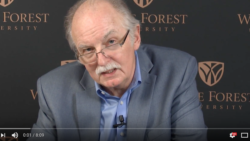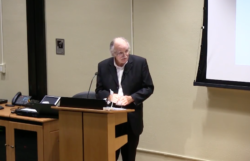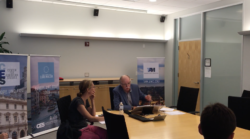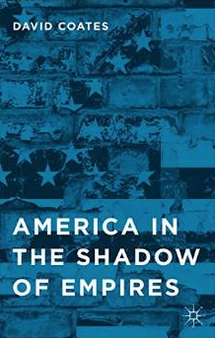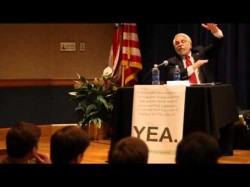The Unfinished Business of the Obama Administration: Bank Reform
As the big five American banks await the downgrading of their credit ratings by Moody’s Investors Service – a downgrading that is apparently due any day now[1] – it is worth asking: after more than three years of the Obama Administration, where exactly are we on the substance of bank reform? Has it happened? Did we miss it? Is it coming? Or in truth, are we – like the characters in a Beckett play – vainly waiting for Godot?
It was all so clear at the beginning. On Inauguration Day 2009, major Wall Street institutions were still teetering on the brink of insolvency and their public standing was at an all-time low.[2] Properly so, since the recklessness of their investment behavior had brought the global credit system to a grinding halt, and their own implosion had been avoided only by an unprecedentedly large injection of public money. When the Obama presidency was new, major bankers summoned before Congressional Committees publicly apologized for the excesses of the institutions they headed, and the over-large bonuses they paid to themselves were the subject of widespread condemnation – including condemnation by the President. The need to more tightly regulate the future behavior of large financial institutions, and to break-up any that were too big to fail, was briefly the conventional wisdom of the age.
It was a conventional wisdom reinforced in January 2011 by the findings of the Financial Crisis Inquiry Commission (FCIC). “We conclude,” the majority of the Commissioners reported, that:
widespread failures in financial regulation and supervision proved devastating to the stability of the nation’s financial markets….dramatic failures of corporate governance and risk management at many systemically important financial institutions were a key cause of this crisis…a combination of excessive borrowing, risky investments and lack of transparency put the financial system on a collision course with crisis….government was ill-prepared for the crisis, and its inconsistent response added to the uncertainty and panic in financial markets….there was a systematic breakdown in accountability and ethics…[and that] collapsing mortgage-lending standards and the mortgage securitization pipeline lit and spread the flame of contagion and crisis.[3]
If that was not enough, the Senate’s own Permanent Subcommittee on Investigations – headed by the Democrat Carl Levin and the Republican Tom Coburn – was sufficiently disturbed by what it discovered about the practices of the major financial players it examined,[4] and so irritated by the lack of co-operation and transparency it received from key witnesses subpoenaed to appear before it, that its critical findings were initially referred to the Justice Department, on the assumption that in addition to folly in the run-up to the 2008 financial crisis, there might also have been criminality.[5]
If that was the entire story, then we could surely have expected several things to follow: (1) a return to safer and more legitimate banking practices, (2) the prosecution of wrongdoing, (3) the moderation of bank bonuses, and (4) full bank co-operation with the creation of stronger regulations.
Actually, none of that has happened.
- We have not returned to safer and more legitimate banking practices. On the contrary, in the years since the financial crisis we have seen major banks mishandle huge numbers of home foreclosures – the so-called robo-signing scandal.[6] We have seen federal regulators fail to pick up that fraud with sufficient speed and diligence.[7] We have seen major delinquent financial institutions – AIG for one – return to the buying of problematic mortgage-backed securities of the kind that initially triggered the crisis.[8] We have seen the continued growth of the shadow banking system,[9] and we have just witnessed one of the big five U.S. banks – JPMorgan Chase – speculating again and losing heavily (to the tune of $2-$3 billion-and-counting), in ways that in 2007 and 2008 had brought the global economy to a halt.[10] Instead of using the original bail-out as the route to direct federal control of banking practices, the Obama Administration has allowed the largest financial institutions to work themselves back to profitability and to return the TARP money that had initially saved them.[11] The result has been the worst kind of capitalism: what Joseph Stiglitz called “ersatz capitalism, the privatizing of gains and the socializing of losses.”[12] Even today, remarkably, JPMorgan Chase (and other large U.S. financial institutions) are still allowed to park the bulk of their derivatives holdings in their commercial bank sections, so gaining FDIC (that is, taxpayer – guaranteed) insurance against loss.[13]
- There has been little or no prosecution of wrongdoing. Or at least, as yet, no major figure has gone to jail. Foreign courts have jailed the odd banker, even – in the case of Iceland – convicting the odd former prime minister;[14] just as, two decades ago, U.S. courts sent more than 800 bankers and thrift executives to jail for abuses related to the Savings and Loans crisis. But not this time.[15] This time, according to the S.E.C’s website, the miniscule “total of 46 top executives have been sued and [just] 25 individuals have been penalized, either by being barred from the industry or from acting as a corporate director or officer.”[16] Many major individuals – but shockingly not always minor ones[17] – have been allowed to settle out of court, avoiding jail altogether: including such key players in the 2008 financial drama as Angelo Mozilo of Countrywide Financial and Joseph Cassano of AIG.[18] And under the legal fiction of “deferred prosecutions,”[19] major financial institutions have been allowed to “settle for pennies on the dollar, with no admission of wrongdoing,” [20] ever where wrongdoing was rife. (Wells Fargo, for example, was fined just $85 million by the Federal Reserve in 2011 for financial irregularities during the subprime bubble.[21]) The Nation Magazine rightly said of these nominal fines, paid by banks in return for promises of future good behavior: it is “not law: it is a toll gate for criminal activity.”[22] The biggest recent toll gate was actually the one erected by the Obama administration: the one that allowed the big five banks to settle their account with foreclosed home owners for a modest $26 billion[23] At least now we have an (admittedly seriously under-resourced) Residential Mortgage-Backed Securities Group, led by federal officials and New York Attorney-General Eric Schneiderman – an investigatory task force which is due to announce its first tranche of prosecutions in the fall.[24] But thus far at least, the major banks have escaped serious penalty for their widespread wrongdoing during the foreclosure crisis; and, as the FCIC chairman Phil Angelides put it, “executives who ran companies that made, packaged and sold trillions of dollars in toxic mortgages and mortgage-backed securities remain largely unscathed.”[25]
- Bank bonuses are back with us with a vengeance. In the immediate wake of the 2008 credit crisis, there was a lull in excessive payments to bankers bailed out by taxpayer dollars: but not for long. As John Cassidy said, “on Wall Street, the Great Recession didn’t last very long. Having sustained losses of $42.6 billion in 2008, the securities industry generated $55 billion in profits in 2009, smashing the previous record, and it paid out $20.3 billion in bonuses.”[26] Indeed the phenomenon is now international. “The world’s big international banks are paying out much more in staff costs relative to profits since the financial crisis while slashing the proportion of income paid out in dividends: staff costs now accounting for 81 per cent of the total payout, as against 58 per cent before the 2008 crisis. [27] It is true that more of that payout is now in deferred compensation: actual cash bonuses fell 14 per cent on Wall Street in 2011.[28] But even so, that diminution is less than the overall fall in industry earnings, and still allows for some staggeringly large personal payouts. The most dramatic of these in 2011 was that to Jamie Dimon. JPMorgan Chase paid him over $23 million: a base salary up from $1 million to $1.5 million, and $17 million in stock options with a $4.5 million cash bonus.[29] Yet in spite of the chief investment division of the bank then losing billions of dollars on an investment model reportedly cleared by Dimon himself,[30] a – the result of risky practices known about at the very top of the bank[31] – JPMorgan Chase has not yet asked for any of its money back. Nor has Dimon felt any need to return any, let alone to do anything so honorable as to resign. We are clearly back once more to a financial world in which “bankers and traders are short on humility and long on arrogance.”[32] That was the world that took us, before 2008, on the road to ruin.
- Instead of full bank co-operation with a strengthening of regulations and over-sight, and a rapid return to the separation of commercial and investment banking as advocated by the Volcker rule, we have now endured three years of steady push-back by leading financial institutions and their CEOs against any major change in the regulatory frameworks within which they are obliged to operate. “The financial industry has spent millions of dollars on lobbying to try to shape the new regulations, according to public records;”[33] so helping to explain why, as late as May 2012, the Davis Polk monthly monitoring of the Dodd-Frank rule-making requirements found that of the 221 rule-making deadlines that had passed, 148 (67 percent) had been missed.[34] The Wall Street push-back began when the Dodd-Frank reforms were working their way through Congress.[35] It continued as the detailed codes required by the new legislation were being designed and implemented;[36] and the push-back continues even today, with leading bankers regularly claiming that more bank regulation can only slow down vital business investment. There is a rich irony in that claim: since business investment has remained low since 2008 precisely because of a generalized recession (and slow economic recovery) triggered by inadequately regulated banking practices. And the irony doesn’t stop there, since we now know that among the very exceptions that JPMorgan Chase lawyers and lobbyists worked hardest to win, when pushing back against the new regulations required by Dodd-Frank, were ones “that would allow banks to make big bets in their portfolios, including some of the types of trading that led to the $2 billion loss now rocking the bank.”[37] With so little new regulation accomplished, and with many of the new regulations being watered down in prolonged consultation processes,[38] it is little wonder that the Fed’s point man on tighter bank regulation, Daniel Tarullo, could go public last month with his “very real concern…that the momentum generated during the crisis will wane or be redirected to other issues before reforms have been completed.”[39]
What does all this tell us? It tells us that in a very real sense the important dimensions of effective bank reform have not so much stalled as simply not happened at all. The case for breaking up the biggest of the banks remains a powerful one, and yet the biggest banks – the ones that took the bulk of the bailout money in 2008 – are actually larger now than they were then.[40] The case for the separation of commercial from investment banking remains equally powerful,[41] and yet we have so far seen no such separation re-established: the detail of the forthcoming Volcker rule remains under discussion, perpetually challenged, and likely when implemented to be woefully inadequate. The institutional causes of the 2008 financial meltdown are now widely recognized, yet they remain firmly in place, threatening us with even more damaging meltdowns to come.[42]
None of this should necessarily surprise us, because the Obama Administration’s record on bank reform remains – to put it as politely as possible – frustratingly uneven: occasionally hot on rhetoric but invariably cold on delivery. “Ever since the current economic crisis began, it has seemed that five words sum up the central principle of United States financial policy: go easy on the bankers.”[43] It is not immediately obvious why. In part, it would appear to be a matter of personalities and policies: the “revolving door” between Wall Street and the White House that leaves a Tim Geithner or a Larry Summers well placed to marginalize an Elizabeth Warren or a Paul Volcker.[44] It may partly be a simple matter of campaign contributions[45] and personal friendships;[46] It may derive from caution associated with the sheer complexity of the financial processes now requiring tight oversight, and the necessary closeness of the working relationship between the regulators and the regulated. But one thing at least is clear. We remain firmly embedded in a financial business culture in which senior executives happily take responsibility for corporate success – and reward themselves generously in the process – while declining to take similar responsibility for corporate failure. No bonuses returned, no falling on their swords by this generation of corporate leaders – that much at least has not changed.
No doubt the historians will eventually tell us quite why and how the speed with which the big banks were bailed out in 2008-9 was not matched later by any similar speed in the creation of a more effective regulatory regime;[47] but by then, of course, it will be way too late. In Beckett’s Waiting for Godot, the two main characters, Vladimir and Estragon, are driven to such a level of frustration by their waiting for someone who never comes, that in the end they consider suicide. We shouldn’t do that – but they did have a point. What does a banker have to do round here to be held responsible for his/her actions? When will this Administration get off the fence, and unambiguously support – in private as well as in public – those federal regulators pushing for effective controls over banking excess. If only for the sake of our sanity, it would be good to know.[48]
[1] Kelly Nolan, Kirsten Grind and Anusha Shrivastava, “Big U.S. Banks Brace for Downgrades,” The Wall Street Journal, June 9, 2012: available at http://online.wsj.com/article/SB10001424052702303296604577454284259305826.html
[2] See David Coates, Making the Progressive Case, New York: Continuum Books, 2011, pp. 12-33 & 160-78: updated at https://www.davidcoates.net/2011/05/26/punishment-or-pushback-financial-regulation-in-the-midst-of-recession/ and https://www.davidcoates.net/2011/11/18/banker-power-trumping-democratic-power-the-crisis-on-two-continents/ and https://www.davidcoates.net/2010/05/07/on-the-regulation-of-wall-street/
[3] FCIC, Final Report of the National Commission on the Causes of the Financial and Economic Crisis in the United States, January 2011, pp. xviii-xxiii: available at http://www.gpo.gov/fdsys/pkg/GPO-FCIC/content-detail.html
[4] The Report focused on Washington Mutual, Goldman Sachs, Moody’s and Standard & Poor’s, and the Office of Thrift Supervision.
[5] The Report, Wall Street and The Financial Crisis: Anatomy of a Financial Crisis, was published April 13, 2011: available at http://www.nytimes.com/interactive/2011/04/14/business/14crisis-docviewer.html
For two alternative views of the report, see Dominic Rushe, ‘Goldman Sachs issue with subpoena over actions during the credit crisis,” The Guardian, June 2, 2011: available at http://www.guardian.co.uk/business/2011/jun/02/goldman-sachs-gets-subpoena-over-credit-crisis-acitivity
and Holman Jenkins, ‘Crime & Punishment and Goldman Sachs,” The Wall Street Journal, June 8, 2011: available at http://online.wsj.com/article/SB10001424052702304432304576371452698816400.html
[6] Details at Brady Dennis, ‘Supervisors directed banks’ mortgage misconduct, HUD report says,” The Washington Post, March 13, 2012: available at http://www.washingtonpost.com/business/economy/supervisors-directed-banks-mortgage-misconduct-hud-report-says/2012/03/13/gIQAqCzq9R_story.html
[7] Brady Dennis, ‘Bank oversight office failed to spot disclosure fraud, Treasury inspector general says,” The Washington Post, June 4, 2012: available at http://foreclosuregate.prosepoint.com/story/bank-oversight-office-failed-spot-foreclosure-fraud-treasury-inspector-general-says
[8] Telis Demos and Nicole Bullock, ‘AIG buys back old mortgage securities,” The Financial Times, February 15, 2012: available at http://www.ft.com/intl/cms/s/0/6efecce2-582a-11e1-bf61-00144feabdc0.html#axzz1xUIe7nug
See also Jacqueline Leo, The Infuriating, Inexcusable AIG Tax Deal, posted on The Huffington Post, March 2, 2012: available at http://www.huffingtonpost.com/jacqueline-leo/the-infuriating-inexcusab_b_1313640.html
and Serena Ng, “Toxic? Says Who? Taste For ‘Subprime’ Returns,” The Wall Street Journal, February 16, 2012: available at http://online.wsj.com/article/SB10001424052970204062704577223473258237102.html
[9] See Kelly Evans, “Banks Run Risks in the Shadows,” The Wall Street Journal, December 5, 2011: available at http://online.wsj.com/article/SB10001424052970204397704577074782946096256.html
Tracy Alloway, “Traditional lenders shiver as shadow banking grows,” The Financial Times, December 28, 2011: available at http://www.ft.com/intl/cms/s/0/f63bea6c-2d5c-11e1-b985-00144feabdc0.html#axzz1xUIe7nug
and Patrick Jenkins, Tom Braithwaite and Brooke Masters, “New threat emerges from the shadows,” The Financial Times, April 9, 2012: available at http://www.ft.com/intl/cms/s/0/32033fc2-7f39-11e1-b3d4-00144feab49a.html#axzz1xUIe7nug
[10] JP Morgan Chase, of course, was the one member of the Big 5 widely praised after 2008 for the rigor of its internal management – its “fortress balance sheet.” It is led by Jamie Dimon, the man who in 2011 publicly condemned tighter international banking rules as “anti-American” and regularly assured the financial community that the Volker rule would be made less onerous before its implantation in July.
(See Paul Krugman, “Dimon’s Déjà Vu Debacle,” The New York Times, May 20. 2012: available at http://www.nytimes.com/2012/05/21/opinion/dimons-deja-vu-debacle.html)
[11] On Wall Street’s return to profitability, and the huge role of public funding in that return, see Zachary A. Goldfarb, “Wall Street’s resurgent prosperity frustrates its claims, and Obama’s,” The Washington Post, November 6, 2011: available at http://www.washingtonpost.com/business/economy/wall-streets-resurgent-prosperity-frustrates-its-claims-and-obamas/2011/10/25/gIQAKPIosM_print.html
[12] Joseph Stiglitz, Freefall, at http://www.businessinsider.com/stiglitz-americas-ersatz-capitalism-is-a-joke-2010-1
[13] On this, see William Greider, “Why is the FDIC Insuring Jamie Dimon’s Mistakes?” The Nation, May 30, 2012: available at http://www.thenation.com/article/168148/why-fdic-insuring-jamie-dimons-mistakes
[14] Julia Werdigier, ‘Ex-Prime Minister of Iceland Convicted on Charge Related to Financial Crisis,” The New York Times DealB%k, April 23, 2012: available at http://dealbook.nytimes.com/2012/04/23/icelands-ex-prime-minister-convicted-of-one-charge-related-to-financial-crisis/
[15] “But today, the rate of federal prosecutions for financial fraud is running at half of what it was then.” (Phil Angelides, “Will Wall Street Ever Face Justice?” The New York Times, March 1, 2012: available at http://www.nytimes.com/2012/03/02/opinion/will-wall-street-ever-face-justice.html)
[16] Gretchen Morgenson, “It Has a Fancy Name, But Will It Get Tough?” The New York Times, January 28, 2012: available at http://www.nytimes.com/2012/01/29/business/mortgage-task-force-has-fancy-name-but-will-it-get-tough.html
[17] See, for example, Joe Nocera, “The Mortgage Fraud Fraud,” The New York Times, June 1, 1012: available at http://4closurefraud.org/2012/06/03/joe-nocera-the-mortgage-fraud-fraud/
[18] See Gretchen Morgenson and Louise Story, “In Financial Crisis, No Prosecutions of Top Figures,” The New York Times, April 14, 2011: available at http://www.nytimes.com/2011/04/14/business/14prosecute.html?pagewanted=all
Three former Washington Mutual executives settled out of court with the FDIC in December 2011, repaying $64 million. (See Tom Braithwaite, “Former WaMu executives in $64m settlement,” The Financial Times, December 13, 2011: available at http://www.ft.com/intl/cms/s/0/9a130eba-25d6-11e1-9c76-00144feabdc0.html#axzz1xUIe7nug)
[19] See Gretchen Morgenson and Louise Story, “As Wall Street Polices Itself, Prosecutors Use Softer Approach,” The New York Times, July 7, 2011: available at http://www.nytimes.com/2011/07/08/business/in-shift-federal-prosecutors-are-lenient-as-companies-break-the-law.html?pagewanted=all
[20] Phil Angelides, “Will Wall Street Ever Face Justice?” The New York Times, March 1, 2012: available at http://www.nytimes.com/2012/03/02/opinion/will-wall-street-ever-face-justice.html
[21] See Joe Nocera, “This Is Considered Punishment?” The New York Times, July 25, 2011: available at http://www.nytimes.com/2011/07/26/opinion/26nocera.html
For details of decisions not to prosecute made by the Department of Justice, see Jeff Madrick and Frank Partnoy, “Should Some Bankers Be Prosecuted,” The New York Review of Books, November 10, 2011: available at http://www.nybooks.com/articles/archives/2011/nov/10/should-some-bankers-be-prosecuted/?pagination=false
For examples of federal judges with more backbone, see Ben Hellman, Wells Fargo Slapped With $3.1 Million Fine For ‘Reprehensible’ Handling Of One Mortgage, posted on The Huffington Post, April 9, 2012: available at http://www.huffingtonpost.com/2012/04/09/elizabeth-magner-new-orleans-wells-fargo_n_1412412.html
and David S. Hilzenrath, “Securities and Exchange Commission faces heat from Democrats over settlement,” The Washington Post, May 18, 2012: available at http://www.washingtonpost.com/business/economy/securities-and-exchange-commission-faces-heat-from-democrats-over-settlements/2012/05/17/gIQAajEGXU_story.html
[22] “Here’s the real scandal. Citigroup has done this many times, getting caught by the S.E.C., promising to be good and getting caught committing the same offense….Over the last fifteen years, Citi has been a repeat offender on interstate commerce fraud, as well as on securities fraud, for a total of eight offenses. In fact, the biggest banks are a rogues’ gallery of recidivists: JP Morgan Chase, six offenses; Bank of America, eight; Morgan Stanley, five; Goldman Sachs, three, Wachovia (now Wells Fargo), three.” (Editorial, “Hold Banks Accountable,” The Nation, December 26, 2011: available at http://www.thenation.com/article/165038/hold-banks-accountable) Edward Wyatt’s reporting on this is also at “S.E.C. Is Avoiding Tough Sanctions for Large Banks,” The New York Times, February 3, 2012: available at http://www.nytimes.com/2012/02/03/business/sec-is-avoiding-tough-sanctions-for-large-banks.html?pagewanted=all
[23] Modest, that is, when set against the current profit levels of the major banks, and modest when set against the $254 billion of mortgages still caught up in the foreclosure process.
(Details in Nelson D. Schwartz and Julie Cresswell, “Mortgage Plan Gives Billions to Homeowners, but With Exceptions,” The New York Times, February 9, 2012: available at http://www.nytimes.com/2012/02/10/business/states-negotiate-26-billion-agreement-for-homeowners.html?pagewanted=all
See also Yves Smith, The Top 12 Reasons Why You Should Hate the Mortgage Settlement, posted on Huffington Post, February 9, 2012: available at http://www.nakedcapitalism.com/2012/02/the-top-twelve-reasons-why-you-should-hate-the-mortgage-settlement.html
[24] David Taintor, Prosecute the Big Banks? ‘Nothing’s Off The Table,’ NY Attorney General Says, posted on TPNDC, June 8, 2012: available at http://tpmdc.talkingpointsmemo.com/2012/06/eric-schneiderman-financial-crisis-task-force-netroots.php
Elizabeth Warren, for one, is still not convinced this move by the Obama administration will be enough. Asked by David Dayen if she was “confident that the investigations in place today will actually lead to the necessary accountability for Wall Street for their role in the crisis?” the Warren answer was a clear negative: “I am not confident. No, and that’s the answer to your question”. This from Dayen’s May 17 posting on Huffington Post (‘Elizabeth Warren Expresses No Confidence in Current Bank Accountability Measures): available at http://news.firedoglake.com/2012/05/17/elizabeth-warren-expresses-no-confidence-in-current-bank-accountability-measures/
[25] Phil Angelides, “Will Wall Street Ever Face Justice?” The New York Times, March 1, 2012: available at http://www.nytimes.com/2012/03/02/opinion/will-wall-street-ever-face-justice.html
[26] John Cassidy, “The Economy: Why They Failed,” The New York Review of Books, December 9, 2010: available at http://www.nybooks.com/articles/archives/2010/dec/09/economy-why-they-failed/?pagination=false
[27] Data from the Financial Times survey, reported in Patrick Jenkins and Patrick Mathurin, “Bank staff costs take bigger share of pot,” The Financial Times, June 5, 2012: available at http://www.ft.com/intl/cms/s/0/d4fe3186-ac0d-11e1-a8a0-00144feabdc0.html#axzz1xUIe7nug
[28] Tom Braithwaite, “Wall Street cash bonuses fell 14% last year,” The Financial Times, March 1, 2012: available at http://www.ft.com/intl/cms/s/0/efa3d820-6314-11e1-9245-00144feabdc0.html#axzz1xUIe7nug
[29] Alexander Besant, JP Morgan Chase CEO Jamie Dimon receives $23 million in compensation, posted on GlobalPost, April 4, 2012: available at http://www.globalpost.com/dispatch/news/business-tech/120404/jp-morgan-ceo-jamie-dimon-receives-23-million-compensation
[30] See Monica Langley, “Inside J. P. Morgan’s Blunder,” The Wall Street Journal, May 18, 2012: available at http://online.wsj.com/article/SB10001424052702303448404577410341236847980.html
[31] Dan Fitzpatrick, Gregory Zuckerman and Joann S Lublin, “J.P. Morgan Knew of Risks,” The Wall Street Journal, June 12, 2012: available at http://online.wsj.com/article/SB10001424052702303768104577460792166155830.html
[32] William Cohan, “The ‘Vampire Squid’ spills its ink,” The Financial Times, March 13, 2012, commenting on Greg Smith’s resignation letter (and op-ed “Why I am Leaving Goldman Sachs”). The Cohan article is available at http://www.ft.com/intl/cms/s/0/ee1c04b4-6deb-11e1-b9c7-00144feab49a.html#axzz1xUIe7nug
The Smith op-ed is at http://www.nytimes.com/2012/03/14/opinion/why-i-am-leaving-goldman-sachs.html?pagewanted=print
[33] Zachary A Goldfarb and Brady Dennis, “Fed’s Tarullo emerges as banks’ key federal foe on regulating risk,” The Washington Post, May 18, 2012: available at http://www.washingtonpost.com/business/economy/feds-tarullo-emerges-as-banks-key-federal-foe-on-regulating-risk/2012/05/18/gIQA9MhCYU_story.html
[34] Davis Polk, Dodd-Frank Progress Report, May 3, 2012: available at http://www.davispolk.com/dodd-frank-rulemaking-progress-report/
[35] For details of the reform, see https://www.davidcoates.net/2010/06/01/u-s-senate-finally-passes-financial-reform/
[36] For the flood of letters from leading financial institutions opposing the Volker rule, and the impact of those letters on the speed of rule-making, see Ben Protess and Peter Eavis, “At Volcker Rule Deadline, a Strong Pushback From Wall St.,” The New York Times DealB%k, February 13, 2012: available at http://dealbook.nytimes.com/2012/02/13/at-volcker-rule-deadline-a-strong-pushback-from-wall-st/
[37] Edward Wyatt, ‘JPMorgan Sought Loophole on Risky Trading,” The New York Times, May 12, 2012: available at http://www.nytimes.com/2012/05/12/business/jpmorgan-chase-fought-rule-on-risky-trading.html?pagewanted=all
[38] See, for example, David S. Hilzenrath, “SEC waters down, adopts disclosure rules for money managers,” The Washington Post, October 26, 2011: available at
[39] Quoted in Goldfarb and Dennis, op. cit: available at http://www.washingtonpost.com/business/economy/feds-tarullo-emerges-as-banks-key-federal-foe-on-regulating-risk/2012/05/18/gIQA9MhCYU_story.html
[40] “All the while, the country’s biggest financial institutions continue to grow. The five largest, which controlled $6.1 trillion in assets before the collapse, by the end of 2011 had assets worth $8.5 trillion – equal to more than half of U.S. economic output, according to Federal Reserve data.” (Patrick Reiss, “Too big to fail bigger than ever,” Politico, May 15, 2012: available at http://www.politico.com/news/stories/0512/76342.html
Legislation proposed in 2010 by Senators Kaufman and Brown to break up the big banks never got past the Democratic Senate leadership, let alone the Republican-controlled House.
[41] For the latest defense, see Luigi Zingales, “Why I was won over by Glass-Steagall,” The Financial Times, June 10, 2012: available at http://www.ft.com/intl/cms/s/0/cb3e52be-b08d-11e1-8b36-00144feabdc0.html#axzz1xUIe7nug
[42] See Simon Johnson’s evidence to Congress, A Healthy Financial System Cannot Be Built on the Expectation of Bailouts,” reproduced on The Huffington Post, March 5, 2011: available at http://www.huffingtonpost.com/simon-johnson/a-healthy-financial-syste_b_831844.html
Also Richard W. Fisher and Harvey Rosenblum, “How Huge Banks Threaten Our Economy,” The Wall Street Journal, April 4, 2012: available at http://online.wsj.com/article/SB10001424052702303816504577312110821340648.html
[43] Paul Krugman, “Letting Bankers Walk,” The New York Times, July 17, 2011: available at http://www.nytimes.com/2011/07/18/opinion/18krugman.html
[44] See Robert Kuttner, The Volcker Rule: Return to Sender, posted on The Huffington Post, February 27, 2012: available at http://www.huffingtonpost.com/robert-kuttner/volcker-rule_b_1303005.html
[45] See David Paul, Why Are our Political Leaders Jumping to Jamie Dimon’s Defense? Posted on The Huffington Post, May 20, 2012: available at http://www.huffingtonpost.com/david-paul/why-are-our-political-lea_b_1530298.html
[46] On Obama’s defense of Jamie Dimon after the $3 billion trading loss became known, see Robert Reich, The Dog That Didn’t Bark: Obama on JPMorgan, posted on The Huffington Post, May, 16, 2012: available at http://www.huffingtonpost.com/robert-reich/obama-jpmorgan_b_1521862.html
[47] On this, see Jeff Connaughton, The Glacial Response of the S.E.C. to the Rise of High-Speed Trading and Market Volatility, posted on The Huffington Post, January 6, 2012: available at http://www.huffingtonpost.com/jeff-connaughton/the-glacial-response-of-t_b_1181378.html
[48] For the counter-case, that now is the time for forgiveness, not prosecution, see Monika Mitchell, Is it Time to Forgive Wall Street? Published on The Huffington Post, June 7, 2012: available at http://www.huffingtonpost.com/monika-mitchell/wall-street-main-street-recession-_b_1575529.html
Tags: bank bonuses, bank reform, Dodd-Frank, financial crisis, foreclosures, Geithner, Jamie Dimon, JPMorgan Chase, Main street, Obama administration, Recession, Wall Street
David Coates holds the Worrell Chair in Anglo-American Studies at Wake Forest University. He is the author of Answering Back: Liberal Responses to Conservative Arguments, New York: Continuum Books, 2010.
He writes here in a personal capacity.
